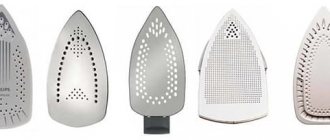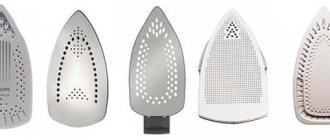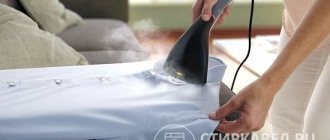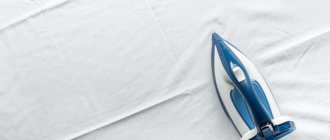Ironing methods using wet gauze or manual spraying are a thing of the past. Modern manufacturers sell irons with a steaming function, which is very convenient and practical. But operating such technology has its own difficulties. Sooner or later, the inner surface of the iron becomes covered with scale of metal salts, which affects the operation of the device itself and the quality of ironing.
Not a single item of household appliance that involves heating water (kettle, steamer, washing machine, dishwasher) is protected from this. In order to solve the problem, you need to understand where scale comes from and how to eliminate it.
Scale is always bad
If scale forms inside the water tank, ironing may leave stains on the laundry that damage the clothes. If heavily soiled, the steam outlets may be completely blocked and this important function will be lost.
To eliminate this undesirable phenomenon, it is necessary to descale your Philips iron. Fortunately, it has a calc clean system. To understand how this system works, watch the video:
The problem of mineral salt deposits on the surface of electrical appliances exists in all devices that use the procedure of heating and boiling water.
For reliable and long-term operation of the ironing device, it is necessary to periodically clean the device from salt deposits. The limescale deposit not only clogs the steam outlets, but also impairs the heat transfer of the device, which can lead to failure.
You can fix this problem like this:
- use the provided self-cleaning function (most models have this function);
- remove plaque with citric acid;
- use acetic acid for this purpose;
- use a special descaling agent.
Self-cleaning functions
No matter how careful the operation of an electrical appliance is, it will last longer only if you carry out regular cleaning. It doesn’t matter what kind of water you fill the tank with, scale will still form. There are several types of self-cleaning and each has its own characteristics.
Calc clean
This is a small button on electrical appliances manufactured by Philips. It triggers the possibility of self-cleaning, which is accompanied by several actions. Used in devices from Philips, Bork, Redmond, Roventa.
Self clean
This function is possible if there is a self-cleaning filter. Self clean is located between the pump and the water reservoir on the iron. This option is needed to reduce the appearance of scale during steam release. It is present in models from Bosch and Brown.
Anti calc
This means using anti-lime cassettes or a rod. They clear the ironing liquid. The rod or cassettes are installed on the switch, which is responsible for supplying steam. Anti calc keeps calcium and magnesium salts from entering the water used to create steam. They are installed in devices from Tefal, Brown, and Moulinex.
Self-cleaning
- Prepare a basin to collect waste liquid. Fill the water container with the maximum level. Turn on the iron to maximum temperature. After heating it will turn off. You need to wait until the device is turned on and off again, and then unplug the plug from the socket.
- Press the self-cleaning button and hold the iron over a previously prepared basin. Steam and pieces of scale will come out of it along with hot water. Cleaning can be done several times until the desired result is obtained.
- Devices that have this function are usually equipped with a special anti-lime rod, which is also cleaned during this procedure.
How to clean a Philips iron from scale inside without a self-cleaning function?
Cleaning cermets and Teflon
Modern types of devices have a surface treated with a material based on silicon, ceramics, enamel, Teflon or special steel alloys.
Do not use products containing abrasive particles to clean them. The cleaning solution should be liquid, gel or paste, homogeneous, without solid crumbs.
Do not remove fumes and scale from a Teflon iron with soda or salt.
The ceramic sole is stronger than Teflon, but is very sensitive to impacts and scratches. The basic cleaning rule is the same as for Teflon - the absence of abrasive components in the cleaning agent that can damage the surface. Just like for Teflon, liquid and paste-like substances are recommended.
A paraffin candle is applied to the hot sole. This cleaning method is suitable for minor stains. It is completely safe.
Cleaning the iron with a candle:
- Wrap the candle in a cloth to avoid getting your hands dirty.
- Heat up the iron.
- Move the candle along the sole, evenly applying paraffin.
- Cool the device, wipe the bottom with a cloth.
Lemon acid
- Dilute the prepared crystals in water in a ratio of 1 g. per 100 ml. water. Typically the capacity of the steamer vessel is 200 ml. – 2 gr. for 200 ml.
- Pour the resulting solution into the iron and turn it on to maximum heat. After turning off, wait until it turns on and off again, remove the plug from the socket and press the steamer button, holding the iron over the basin. Steam and hot water with pieces of scale will come out of the holes. The procedure must be repeated and carried out until complete cleaning. You may need 3-4 repeat surgeries. When finished, wipe the sole with a soft cloth or napkin.
Vinegar
- Prepare a container with low sides into which the iron will fit. This could be a baking tray or a deep frying pan.
- Prepare a vinegar solution at the rate of two glasses per liter of water. Solution concentration – 4.5%. When using 70% vinegar essence, the proportion will be different. For 1 liter of water, take 60-65 ml of vinegar essence.
- Place the device on a baking sheet and fill with the prepared solution. The back should be higher than the front, the liquid level should be slightly higher than the sole. For this you can use wooden blocks and sticks.
- Place the pan on the fire and bring to a boil. The reaction begins immediately. Pause for 25-30 minutes and repeat heating. This will clean the soleplate and steam holes.
- When finished, rinse with clean water and wipe dry.
You cannot use the device right away; you need to give it time to dry, because when treating the iron with this method, water can get on elements that are energized during operation.
Remember that during operation an unpleasant odor will be released, so the treatment should be carried out in a well-ventilated area, or in the presence of an exhaust hood above the stove.
Video
In order to understand the nuances of cleaning steam generators, check out the presented videos:
Young mother, wife and part-time freelancer. Being a lawyer by training, I am accustomed to collecting and providing the most complete and reliable information. Constantly improves in the professional field and strives for personal growth and development.
Found a mistake? Select the text with the mouse and click:
Fresh lemon is not only suitable for tea: clean dirt from the surface of an acrylic bath by rubbing with half a cut citrus, or quickly wash the microwave by placing a container of water and lemon slices in it for 8-10 minutes at maximum power. The softened dirt can simply be wiped off with a sponge.
The easiest way to remove scale and carbon deposits from the soleplate of the iron is with table salt. Pour a thick layer of salt onto the paper, heat the iron to maximum and run the iron over the salt bed several times, applying light pressure.
The habit of using an automatic washing machine “sparingly” can lead to the appearance of an unpleasant odor in it. Washing at temperatures below 60℃ and short rinses allow fungi and bacteria from dirty clothes to remain on internal surfaces and actively multiply.
Threads made of gold and silver, which were used to embroider clothes in the old days, are called gimp. To obtain them, the metal wire was pulled for a long time with pliers to the required fineness. This is where the expression “to drag out the rigmarole” came from - “to do long, monotonous work” or “to delay the completion of a task.”
If your favorite things show the first signs of gestation in the form of untidy pellets, you can get rid of them using a special machine - a shaver. It quickly and effectively shaves off clumps of fabric fibers and returns things to their proper appearance.
Stretch ceilings made of PVC film can withstand from 70 to 120 liters of water per 1 m2 of their area (depending on the size of the ceiling, the degree of its tension and the quality of the film). So you don’t have to worry about leaks from neighbors above.
The dishwasher cleans more than just plates and cups. You can load it with plastic toys, glass lamp shades and even dirty vegetables, such as potatoes, but only without using detergents.
Before removing various stains from clothing, you need to find out how safe the selected solvent is for the fabric itself. It is applied in a small amount to an inconspicuous area of the item from the inside out for 5-10 minutes. If the material retains its structure and color, you can move on to stains.
There are special traps to combat moths. The sticky layer with which they are covered contains female pheromones that attract males. By sticking to the trap, they are eliminated from the reproduction process, which leads to a decrease in the moth population.
Special products for removing salt deposits
The industry produces a variety of iron care products. Instructions for use are the same for everyone or differ slightly from each other:
- pour descaling solution into container
- turn on the network at maximum temperature
- after turning off, press the self-cleaning button or, if it is absent, the steam release button over a pre-prepared container (basin, large pan)
- repeat 3-4 times adding liquid to the container
- rinse the device with clean water until the remaining solution is completely removed
Scale is always bad
If scale forms inside the water tank, ironing may leave stains on the laundry that damage the clothes. If heavily soiled, the steam outlets may be completely blocked and this important function will be lost.
To eliminate this undesirable phenomenon, it is necessary to descale your Philips iron. Fortunately, it has a calc clean system. To understand how this system works, watch the video:
The problem of mineral salt deposits on the surface of electrical appliances exists in all devices that use the procedure of heating and boiling water.
For reliable and long-term operation of the ironing device, it is necessary to periodically clean the device from salt deposits. The limescale deposit not only clogs the steam outlets, but also impairs the heat transfer of the device, which can lead to failure.
You can fix this problem like this:
- use the provided self-cleaning function (most models have this function);
- remove plaque with citric acid;
- use acetic acid for this purpose;
- use a special descaling agent.
Restoring the performance of the philips gc 4411 iron
When the above iron does not steam, it means that the tank is overloaded with scale on the walls. The right solution in such cases would be to enable the Quick Calc Release function. The manufacturer recommends connecting the function every 3-4 weeks to clean the tank.
It is important to let the iron cool down before using the Quick Calc Release. The device is placed horizontally and the system lock on the surface of the rear panel is activated.
The next step is to descale the iron with Quick Calc Release by removing the stand and draining the deposits into the sink. The stand itself is washed, thoroughly dried, and the remaining scale in the holes of the system is removed with a damp cloth.
After processing, the stand is returned to its place and secured.
Self-cleaning
- Prepare a basin to collect waste liquid. Fill the water container with the maximum level. Turn on the iron to maximum temperature. After heating it will turn off. You need to wait until the device is turned on and off again, and then unplug the plug from the socket.
- Press the self-cleaning button and hold the iron over a previously prepared basin. Steam and pieces of scale will come out of it along with hot water. Cleaning can be done several times until the desired result is obtained.
- Devices that have this function are usually equipped with a special anti-lime rod, which is also cleaned during this procedure.
How to clean a Philips iron from scale inside without a self-cleaning function?
Why is cleaning necessary?
During the operation of a steam station, the thin channels through which steam passes become clogged with lime deposits, which are formed from salts present in tap water. Scale creates a number of inconveniences, such as difficult passage of steam jets and the appearance of dirty stains and lime flakes on the laundry. This necessitates washing things, and if yellow spots form, it renders the item completely unusable. Many models of steam generators are equipped with a self-cleaning function, however, when using low-quality water, the system is not able to cope with scale on its own and requires outside help.
Lemon acid
- Dilute the prepared crystals in water in a ratio of 1 g. per 100 ml. water. Typically the capacity of the steamer vessel is 200 ml. – 2 gr. for 200 ml.
- Pour the resulting solution into the iron and turn it on to maximum heat. After turning off, wait until it turns on and off again, remove the plug from the socket and press the steamer button, holding the iron over the basin. Steam and hot water with pieces of scale will come out of the holes. The procedure must be repeated and carried out until complete cleaning. You may need 3-4 repeat surgeries. When finished, wipe the sole with a soft cloth or napkin.
Vinegar
- Prepare a container with low sides into which the iron will fit. This could be a baking tray or a deep frying pan.
- Prepare a vinegar solution at the rate of two glasses per liter of water. Solution concentration – 4.5%. When using 70% vinegar essence, the proportion will be different. For 1 liter of water, take 60-65 ml of vinegar essence.
- Place the device on a baking sheet and fill with the prepared solution. The back should be higher than the front, the liquid level should be slightly higher than the sole. For this you can use wooden blocks and sticks.
- Place the pan on the fire and bring to a boil. The reaction begins immediately. Pause for 25-30 minutes and repeat heating. This will clean the soleplate and steam holes.
- When finished, rinse with clean water and wipe dry.
Special products for removing salt deposits
The industry produces a variety of iron care products. Instructions for use are the same for everyone or differ slightly from each other:
- pour descaling solution into container
- turn on the network at maximum temperature
- after turning off, press the self-cleaning button or, if it is absent, the steam release button over a pre-prepared container (basin, large pan)
- repeat 3-4 times adding liquid to the container
- rinse the device with clean water until the remaining solution is completely removed
General recommendations for all types of cleaning Philips irons:
- When preparing a descaling solution, you must strictly observe the proportions so as not to harm the rubber and silicone gaskets
- use purified or boiled water. When pouring a ready-made descaling solution, check whether it needs to be diluted and in what proportion
- For safety reasons, carry out procedures only with the iron unplugged
- After finishing work, rinse the container 2-3 times with clean water.
To prevent the formation of salt deposits inside the water tank, as well as in the steam outlets, the following recommendations must be followed:
- pour only boiled water or a mixture of tap and distilled water into the vessel in a ratio of 1:3
- during breaks, place the device in a vertical position
- After ironing, drain the remaining liquid
- purchase a special water purification filter for ironing, which can be purchased separately
Modern ironing devices have a built-in filter, the operating time of which is calculated for the entire operating time of the device.
Manufacturers do not recommend using only distilled water; steam will form worse. The effect of overheated steam occurs, which negatively affects the smoothing process.
Has scale appeared after using your steam iron extensively? Are flakes coming out of the appliance's holes, leaving unsightly stains on the fabric? Don't know what to do about it? Regular cleaning can help keep your electrical appliance performing at a high level. This article will reveal the secrets of how to clean the inside of a Philips iron from scale at home and how to carry out preventive maintenance for active use without problems.
Conclusion
The process of removing plaque is not complicated. The main thing is to do the procedure on time and regularly. Use clean water, not hard water, to avoid problems. After each ironing, wipe the sole with a cloth soaked in water.
Has scale appeared after using your steam iron extensively? Are flakes coming out of the appliance's holes, leaving unsightly stains on the fabric? Don't know what to do about it? Regular cleaning can help keep your electrical appliance performing at a high level. This article will reveal the secrets of how to clean the inside of a Philips iron from scale at home and how to carry out preventive maintenance for active use without problems.
How to know when the device needs to be cleaned
When using purified water for operation, scale still forms inside the household appliance. Subsequently, the steam holes on the sole become clogged, leading to loss of functionality. Manufacturers' instructions for steam irons warn that distilled water must be used. It does not contain mineral salts, so less limescale will accumulate on the walls of the inner container.
Signs that cleaning is already necessary:
- the sole touches things;
- the pressure pushing out the steam has become less or not at all;
- yellow stains remain on clothes;
- the iron has become heavier (this is a critical case).
If there is at least one of the above problems, then it’s time to take action. Cleaning options:
- wash the tank using folk remedies;
- remove scale using suitable substances;
- clean the internal water purification tank;
- enable the self-cleaning function.
The choice of solution to the problem depends on the model of the electrical household appliance.
Prevention measures
In order for the steam generator to last as long as possible and be less susceptible to scale formation, it is recommended to follow a number of simple rules. For example, only filtered or melted water should be poured into the tank. Tap water contains a large amount of salts and impurities, so it is prohibited to use it unfiltered. Boiled water is also not suitable for steam cleaners, as it forms sediment during the boiling process. As for distilled water, it has too high a vaporization temperature, so it is far from the best option. Spring water contains a large amount of minerals and salts, which quickly turn into scale, and a special flavored liquid often leaves stains on clothes.
If you use the device regularly, it should be cleaned at least 2 times a month, and after each use, be sure to drain the remaining water from the reservoir. It is not recommended to clean the steam cleaner using hard sponges and abrasive substances, as well as products containing hydrochloric acid.
See below for the steam generator cleaning method.
Anti-scale protection
Preventative cleaning of your Philips iron is very important. The main thing is to determine which filter or cassette is in the device. They come in two types: permanent and replaceable.
The first option is designed for the entire period of operation, but it needs to be descaled from time to time. Instructions on how to do this:
- pull out the rod;
- place in sour lemon solution;
- hold for 2 hours;
- rinse under clean running water;
- return to place.
Replacement cassettes simply need to be changed after the set period has expired.
Peculiarities
An iron from any manufacturer has its own structure. The structure of the Braun models includes an anti-calc rod (Anti Calc) or cassettes. They are used to filter water and prevent the release of salt particles and other sediments.
To use our function, you need to remove such “gadgets” from the iron and clean them separately. Execution order:
- Immerse the rod in a vessel with lemon juice or a specialized descaler for 4-5 hours.
- After time has passed, it must be pulled out and washed under high water pressure.
Thanks to careful use, modern irons have been pleasing housewives for years. And by choosing a device with a self-cleaning system, you can forget about the problems of scale and white stains on things.
Self-cleaning
To clean the inside of a Philips iron from scale at home, you must do the following:
- Pour settled water into the built-in reservoir and turn on the “no steam” function;
- after complete heating, remove the plug from the socket;
- bring the iron to the sink;
- turn on the Calc-Clean button (controller) and hold it;
- shake the device to help the steam push scale out of the holes;
- turn on the iron, heat it up, iron it with a soft towel to clean the sole.
Traditional methods
For long-term and reliable operation, several options for descaling are used. Failure to take these steps may result in poor heat transfer or failure of the device.
Vinegar
For the cleaning procedure to be successful, you must:
- take water, vinegar (proportion 1:1);
- pour 1/3 into the inner container;
- heat the electrical appliance to a high temperature;
- stand for 10 minutes;
- the Philips iron will turn on and off on its own without interfering with the process;
- hold it horizontally over the bowl while pressing the “steam” button;
- Perform the procedure until the liquid in the reservoir runs out;
- fill it with purified water, turn it on, heat it up strongly, releasing steam, the remaining scale will come out with it;
- Drain off the remaining water and wipe the base with a clean cloth.
To avoid inhaling harmful vinegar fumes, you need to work with the window open.
Sparkling water
Pour water (200 ml) into the inner container and heat the iron high. Select the “steam” function and press the button. All the exfoliated scale will come out. Repeat the process several times until clean water comes out.
Tribasic carboxylic acid
Using citric acid, you can effectively clean the inside of your Philips iron from scale at home.
- Dissolve 20–25 g of citric acid in a glass of water at room temperature;
- pour the product into a well-heated iron;
- stand for 10 minutes;
- hold over the sink, release steam by pressing the button until rust comes out of the holes in the sole;
- drain the iron and fill it with purified water;
- continue releasing steam;
- Wipe the base of the device with a clean cloth.
Troubleshooting This section is dedicated to the most…
Page 10
- Image
- Text
Troubleshooting
This section is devoted to the most general issues of using an iron. If you are unable to resolve the issue yourself, please contact the Philips Customer Care Center in your country.
RUSSIAN
41
Comments
The red indicator blinks twice, the iron does not turn on
Vyacheslav 10/21/2020 15:58 GMT
Select → I found the instructions for my iron here! #manualza
- Click →
I bought a scooter for my granddaughter. According to my assumptions, it is intended for children under 6 years old. I carefully read the instructions. Clause 10 reads: - It is prohibited to use this product while under the influence of alcohol or other intoxication...
Manualza!manualza.ru
Still not with us?
Cleaning the sole
If you have already gotten rid of the internal scale, you should update the outer part of the iron. This can be done using effective, simple methods.
Laundry soap
An inexpensive home method will allow you to tidy up your household appliance. You need to heat it to a high temperature and apply a pre-prepared soap solution of 72% soap to the sole. Wipe off any residue with a sponge or cloth. If the product gets into the holes, pull it out with cotton swabs and then blow them out with steam.
Pour kitchen salt onto a napkin, thoroughly wipe the base of the iron, the stains will go away. The “steam” function should be disabled at this moment. This method is not suitable for Teflon coating.
Paraffin
Wrap the candle in a cotton napkin and wipe the heated iron in a circular motion. To avoid staining the table with paraffin, you need to place paper under the household appliance. The holes on the sole may require additional cleaning.
Hydrogen peroxide
Immerse the sponge in the solution and apply to a cold base. Give it time to soak, wipe, the carbon deposits will disappear.
Vinegar with ammonia
Used if the bottom of the iron is severely damaged. Mix the liquids in a 1:1 ratio and moisten the base of the device. If there is no positive result, leave the moistened napkin for 2 hours, you will be able to soften the scale and remove it.
To clean an electric iron in this simple way, you need to dissolve 1 tbsp. l. soda in water, moisten a rag and wipe the bottom of the device. It should be cold or slightly warm.
Acetone
It will help even if artificial fabric or polyethylene has stuck to the surface after ironing. Soak a swab in nail polish remover and wipe off the stuck pieces. An important condition is not to touch the plastic body, as the Philips iron can damage it.
Hydroperite
An excellent cleaner in tablet form. Heat the iron and rub the surface well. Allow time to cool and wipe the base with a soft cloth.
Toothpaste
Prepare a paste from water and paste. Wipe the bottom of the electrical appliance. Then rinse everything off and wipe dry with a soft cloth.
There is a special anti-scale pencil suitable for different models of irons. It lubricates the entire surface. When it starts to melt, then you need to remove it along with the scale.
Cleansing can be done using an extreme method, using sulfur from a matchbox. First heat the surface and rub the base of the device with the sulfur on the side, wipe with a clean cloth.
How to clean your iron from carbon deposits at home - 7 effective methods!
How to clean an iron from carbon deposits at home, except using folk remedies? Although, as a rule, modern models have a built-in function for removing carbon deposits and scale. A stream of hot steam escapes from the device, which cleans its surface.
For cotton
However, some models do not have such a function or it may not work correctly. In this case, the following will help against burning:
- hydrogen peroxide;
- baking soda;
- paraffin candle and salt;
- table vinegar;
- pencil for cleaning burnt fabric.
Next, we’ll look at all the ways you can clean your iron in more detail.
Hydrogen peroxide or how to clean an iron from carbon deposits at home
The most effective method for cleaning your iron from carbon deposits at home is to use hydrogen peroxide. This is an equally common element in everyday life, and therefore the process promises to be fast and quite effective.
hydrogen peroxide
| Take an unnecessary gauze cloth or towel. Wet it with hydrogen peroxide. |
| Turn on the device and bring it to maximum temperature. |
| Iron the cloth for 2-3 minutes. |
| The sole has been cleaned. Now all that remains is to go through the exit holes. To do this, take a cotton swab and moisten it with peroxide. Then we wipe each hole. |
How to clean an iron with salt, how to clean an iron at home
The most easily accessible cleaning method is regular kitchen salt. There are many options for how to clean your iron with salt. The most effective one is as follows:
| Take a sheet of A4 paper and salt. Spread it evenly over the entire surface. |
| Turn on the iron and bring it to maximum temperature. We pass it along a sheet of salt. |
| Remove any remaining salt using a cloth. |
Nail polish remover or how to clean an iron from burnt fabric
How to clean burnt fabric from an iron using nail polish remover? Acetone, which is included in its composition, can quite easily cope with carbon deposits on any surface.
| Dampen a cloth with acetone and wipe the cold, burnt sole. |
| Next, turn it on at full power and iron it with a gauze cloth or towel. It is necessary to turn on the steam function periodically. |
| We remove the remaining dirt with a cloth and cotton swabs. |
How to clean the surface of an iron with baking soda?
Our grandmothers always had this miracle product at hand, but today few people know how to clean the surface of an iron with baking soda from burnt marks and rust.
baking soda
| Place a tablespoon of baking soda in a bowl and fill it with water. Then we dip a rag and wipe the cold surface with it. Turn it on and remove any remaining dirt. For greater effect, you can turn on the steam mode. |
Paraffin candle
This is a rather troublesome, but no less effective means for cleaning an iron. Let's look at the step-by-step process.
| Take a paraffin candle and rub it on a grater. |
| Spread evenly over the surface. Then add a little table salt. |
| Place a gauze cloth on top. |
| We heat the device to maximum temperature and then place it on a rag or napkin. Hold until a wet, dirty mark appears on the napkin. Remove the residue with a rag. |
How to clean an iron from burnt marks on the soles with table vinegar
How to clean an iron from burnt marks on the sole using table vinegar? This is another fairly affordable and not labor-intensive method. Wipe contaminated areas of the cold sole with a cotton swab or cotton cloth soaked in a 9% solution of table vinegar. If the plaque cannot be cleaned off so easily, then you can leave the iron on a cloth soaked in table vinegar for 7-10 hours. After such an event, the burnt fabric softens and comes off easily when wiped with a rough cloth.
| We take the affected device, vinegar and cotton swabs. |
| We heat it up, and then soak a cotton swab in vinegar and wipe the hot sole with it. Three until the dirt is gone. At the end, turn on the steam and remove any remaining carbon deposits. |
Cleaning the iron at home from carbon deposits with a special pencil
Cleaning your iron at home from carbon deposits with a special pencil is one of the wonders of household chemicals. It is shaped like a candle, but quite hard and crystalline. It's not difficult to use at all. Let's look at an example.
| Heat to maximum temperature. Then we draw a pencil over the surface. Its contents should flow down the sole. |
| As a result, the burn will begin to foam and a not very good smell will appear. Therefore, it is best to perform the procedure either outdoors or in a ventilated area wearing a mask. |
| At the end we wipe everything with a cloth. |











